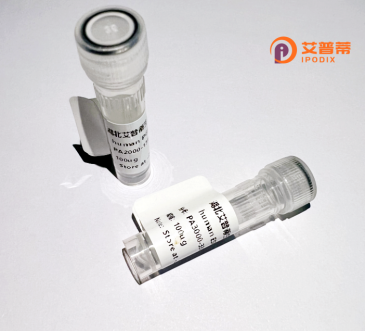
| 纯度 | >90%SDS-PAGE. |
| 种属 | Human |
| 靶点 | ZNF281 |
| Uniprot No | Q9Y2X9 |
| 内毒素 | < 0.01EU/μg |
| 表达宿主 | E.coli |
| 表达区间 | 1-895 aa |
| 活性数据 | MKIGSGFLSGGGGTGSSGGSGSGGGGSGGGGGGGSSGRRAEMEPTFPQGMVMFNHRLPPVTSFTRPAGSAAPPPQCVLSSSTSAAPAAEPPPPPAPDMTFKKEPAASAAAFPSQRTSWGFLQSLVSIKQEKPADPEEQQSHHHHHHHHYGGLFAGAEERSPGLGGGEGGSHGVIQDLSILHQHVQQQPAQHHRDVLLSSSSRTDDHHGTEEPKQDTNVKKAKRPKPESQGIKAKRKPSASSKPSLVGDGEGAILSPSQKPHICDHCSAAFRSSYHLRRHVLIHTGERPFQCSQCSMGFIQKYLLQRHEKIHSREKPFGCDQCSMKFIQKYHMERHKRTHSGEKPYKCDTCQQYFSRTDRLLKHRRTCGEVIVKGATSAEPGSSNHTNMGNLAVLSQGNTSSSRRKTKSKSIAIENKEQKTGKTNESQISNNINMQSYSVEMPTVSSSGGIIGTGIDELQKRVPKLIFKKGSRKNTDKNYLNFVSPLPDIVGQKSLSGKPSGSLGIVSNNSVETIGLLQSTSGKQGQISSNYDDAMQFSKKRRYLPTASSNSAFSINVGHMVSQQSVIQSAGVSVLDNEAPLSLIDSSALNAEIKSCHDKSGIPDEVLQSILDQYSNKSESQKEDPFNIAEPRVDLHTSGEHSELVQEENLSPGTQTPSNDKASMLQEYSKYLQQAFEKSTNASFTLGHGFQFVSLSSPLHNHTLFPEKQIYTTSPLECGFGQSVTSVLPSSLPKPPFGMLFGSQPGLYLSALDATHQQLTPSQELDDLIDSQKNLETSSAFQSSSQKLTSQKEQKNLESSTGFQIPSQELASQIDPQKDIEPRTTYQIENFAQAFGSQFKSGSRVPMTFITNSNGEVDHRVRTSVSDFSGYTNMMSDVSEPCSTRVKTPTSQSYR |
| 分子量 | 123.3 kDa |
| 蛋白标签 | His tag N-Terminus |
| 缓冲液 | PBS, pH7.4, containing 0.01% SKL, 1mM DTT, 5% Trehalose and Proclin300. |
| 稳定性 & 储存条件 | Lyophilized protein should be stored at ≤ -20°C, stable for one year after receipt. Reconstituted protein solution can be stored at 2-8°C for 2-7 days. Aliquots of reconstituted samples are stable at ≤ -20°C for 3 months. |
| 复溶 | Always centrifuge tubes before opening.Do not mix by vortex or pipetting. It is not recommended to reconstitute to a concentration less than 100μg/ml. Dissolve the lyophilized protein in distilled water. Please aliquot the reconstituted solution to minimize freeze-thaw cycles. |
1. **"ZNF281 is a transcriptional regulator of the oncogene SIAH1 in colorectal cancer"**
*Author: Frank T. Kolligs et al.*
**摘要**:该研究发现ZNF281蛋白作为转录因子调控结直肠癌中SIAH1的表达,通过激活Wnt/β-catenin信号通路促进肿瘤细胞增殖和侵袭,揭示了其在癌症进展中的关键作用。
2. **"ZNF281 interacts with the pluripotency factors OCT4 and SOX2 to maintain embryonic stem cell identity"**
*Author: Susanne Harnack et al.*
**摘要**:研究通过ChIP-seq和功能实验证明,ZNF281与多能性因子OCT4、SOX2协同作用,直接调控Nanog等干细胞关键基因,维持胚胎干细胞的自我更新和多能性。
3. **"ZNF281 promotes DNA damage-induced apoptosis by repressing p21 transcription"**
*Author: Bin Huang et al.*
**摘要**:文章揭示ZNF281在DNA损伤应答中通过抑制p21的转录表达,增强p53依赖性凋亡通路,表明其在细胞周期调控和基因组稳定性中的双重作用。
4. **"ZNF281 recruits histone methyltransferase complexes to regulate chromatin remodeling in cancer metastasis"**
*Author: Xiaodong Wang et al.*
**摘要**:该研究报道ZNF281通过结合EZH2等组蛋白修饰酶,介导靶基因启动子的H3K27me3修饰,抑制上皮标志物表达,进而驱动肿瘤细胞的EMT过程及转移。
---
以上文献涵盖ZNF281在癌症、干细胞、DNA损伤和表观遗传调控中的作用,均涉及重组蛋白的功能机制研究。
ZNF281. a member of the zinc finger protein family, is a transcription factor encoded by the *ZNF281* gene in humans. It contains multiple Cys2-His2 (C2H2) zinc finger motifs at its C-terminus, enabling sequence-specific DNA binding, and an N-terminal repression domain that mediates interactions with chromatin-modifying complexes like the Polycomb repressive complex (PRC). Primarily localized in the nucleus, ZNF281 plays critical roles in regulating gene expression networks tied to embryonic development, stem cell pluripotency, and cellular differentiation. It functions as a repressor or activator depending on context, often crosstalk-ing with signaling pathways such as Wnt/β-catenin and TGF-β.
In cancer biology, ZNF281 exhibits dual roles: it promotes tumor progression by driving epithelial-mesenchymal transition (EMT) and metastasis in colorectal, breast, and pancreatic cancers, yet acts as a tumor suppressor in certain contexts by inhibiting proliferation. Its involvement in maintaining stem-like properties of cancer cells underscores its therapeutic relevance. Recombinant human ZNF281 protein, typically produced in *E. coli* or mammalian systems with affinity tags (e.g., His-tag), is widely used in *in vitro* studies to dissect DNA-binding specificity, protein-protein interactions, and transcriptional mechanisms. Researchers also employ it to model ZNF281's role in reprogramming somatic cells, regulating cell cycle checkpoints, and modulating chemoresistance. Despite progress, its context-dependent regulatory dynamics and therapeutic targeting potential remain active areas of investigation.
×